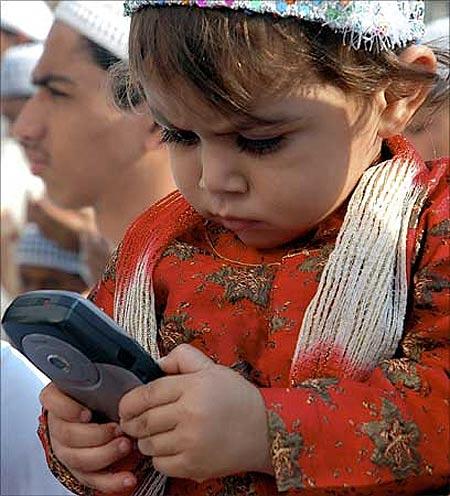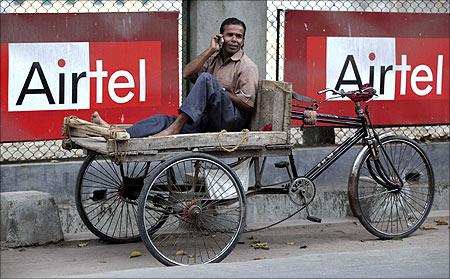Photographs: Reuters. Mansi Taneja in New Delhi
The lifetime-validity schemes that once led to explosive growth in subscriber base for the mobile telephony industry did not last a lifetime.
As all telecom operators have started a drive to clean up 'inactive' numbers, the lifetime prepaid cards (which had to be recharged once in six months, without any usage conditions) are being disconnected in the event of no usage for two months.
For new subscribers, there is a pre-set condition of usage now.
...
Why lifetime mobile schemes did not last
Image: For lifetime numbers, there were no usage conditions.Photographs: Reuters.
For lifetime numbers, there were no usage conditions. The schemes were started by all the operators five-six years back.
One of the reasons cited was these would make things easier for customers, as with lifetime schemes they would not have to recharge their accounts every month to extend the validity.
...
Why lifetime mobile schemes did not last
Image: Initiative helped the operators garner more users.Photographs: Reuters.
The other, bigger, reason was to drive growth in subscriber numbers by offering attractive call tariffs through such schemes, which involved paying a small upfront charge for several months and free incoming calls.
The initiative helped the operators garner more users and make India the second largest wireless market after China.
...
Why lifetime mobile schemes did not last
Image: 80-90 per cent of all prepaid customers were acquired by all operators on lifetime plans.Photographs: Reuters.
Cellular Operators' Association of India (COAI) Director General Rajan Mathews said, "There won't be any future lifetime schemes from operators. When these schemes were introduced, it was an era of high mobile tariffs. Now, with so low tariffs, nobody would be willing to pay a fixed amount in advance for lifetime numbers."
An executive of a telecom player, which also offered lifetime schemes, said, "Since the launch of lifetime schemes, about 80-90 per cent of all prepaid customers were acquired by all operators on lifetime plans.
...
Why lifetime mobile schemes did not last
Image: Subscribers would buy a connection and recharge once in six months.Mostly, subscribers would buy a connection and recharge once in six months, but not use their phones for three or four months at a stretch because people had multiple SIMs. For outgoing calls, they mostly used the one that offered the lowest tariff."
But now, with a dearth of new numbers to allot, the Department of Telecommunications (DoT) has directed all telecom players to weed out their inactive subscriber base.
...
Why lifetime mobile schemes did not last
Image: Only 626.18 million of the users were active.DoT refused to allot a new numbering series till all the inactive numbers were removed.
The latest subscriber figures by telecom regulator, Trai, showed only 626.18 million of the users were active out of a total base of 881.40 million at the end of October 2011.
The DoT directive prompted Bharti Airtel and Vodafone to write to Trai, informing it about the disconnection of numbers not in use for two months. All the other old operators have also started the clean-up drive.
...
Why lifetime mobile schemes did not last
Image: Concept of lifetime connections dead.The whole concept of lifetime connections, in which subscribers had the right to use their numbers whenever they wanted, was dead in the wake of these developments, said an executive from another telecom company.
...
Why lifetime mobile schemes did not last
A senior DoT official said, "The allocation of a new numbering series is not feasible at this point of time as it will involve a major change in the whole system to align old mobile numbers with the new. So, we have asked operators to clear their inactive subscriber base and allot those numbers to new subscribers."
The proposal before the DoT was to allocate an 11-digit numbering series, from the existing 10-digit series.









article